[最新]pep四年级英语上册Unit 4 Part B说课稿.doc
PEP小学四年级英语上册第四单元Unit 4 My home PartB Let’s learn说课稿
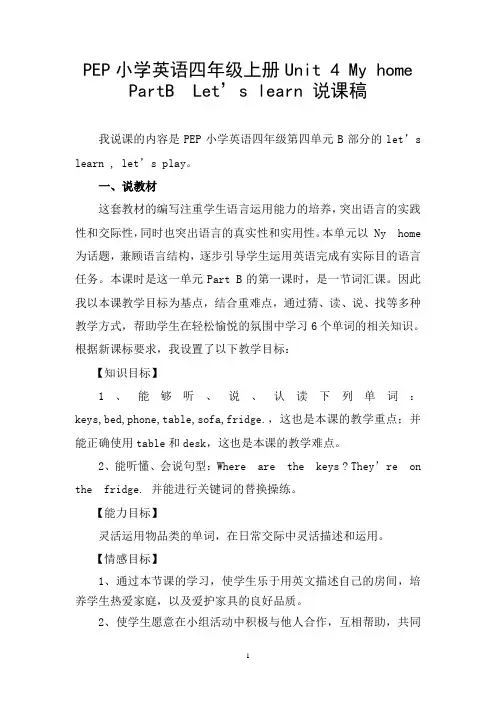
PEP小学英语四年级上册Unit 4 My home PartB Let’s learn 说课稿我说课的内容是PEP小学英语四年级第四单元B部分的let’s learn , let’s play。
一、说教材这套教材的编写注重学生语言运用能力的培养,突出语言的实践性和交际性,同时也突出语言的真实性和实用性。
本单元以 Ny home 为话题,兼顾语言结构,逐步引导学生运用英语完成有实际目的语言任务。
本课时是这一单元Part B的第一课时,是一节词汇课。
因此我以本课教学目标为基点,结合重难点,通过猜、读、说、找等多种教学方式,帮助学生在轻松愉悦的氛围中学习6个单词的相关知识。
根据新课标要求,我设置了以下教学目标:【知识目标】1、能够听、说、认读下列单词:keys,bed,phone,table,sofa,fridge.,这也是本课的教学重点;并能正确使用table和desk,这也是本课的教学难点。
2、能听懂、会说句型:Where are the keys ? They’re on the fridge. 并能进行关键词的替换操练。
【能力目标】灵活运用物品类的单词,在日常交际中灵活描述和运用。
【情感目标】1、通过本节课的学习,使学生乐于用英文描述自己的房间,培养学生热爱家庭,以及爱护家具的良好品质。
2、使学生愿意在小组活动中积极与他人合作,互相帮助,共同完成学习任务。
二、说教法为了顺利完成教学目标,更好地突出重点,突破难点,按照学生的认识规律,我采用情景假设法、直观演示法、交际法、游戏法相结合的方法。
兴趣是学生最好的老师,小学低年级英语更注重趣味教学,在课堂上适当运用肢体语言、游戏法,激发学生学习英语的兴趣,进而促使学生由兴趣发展到产生要学好它的志趣。
教师通过直观演示法,引导学生用英语表达自己的思想和感受。
在调动学生积极性和主动性方面,我采用了游戏法,让全班参与其中,形成师生互动,提高教学效果。
三、说学法小学四年级学生已经学了一年的英语,已掌握了基本的听、说、认读能力,已具备了一定的自学能力。
(PEP)四年级英语上册 Unit 4 Part B Let's talk 教案
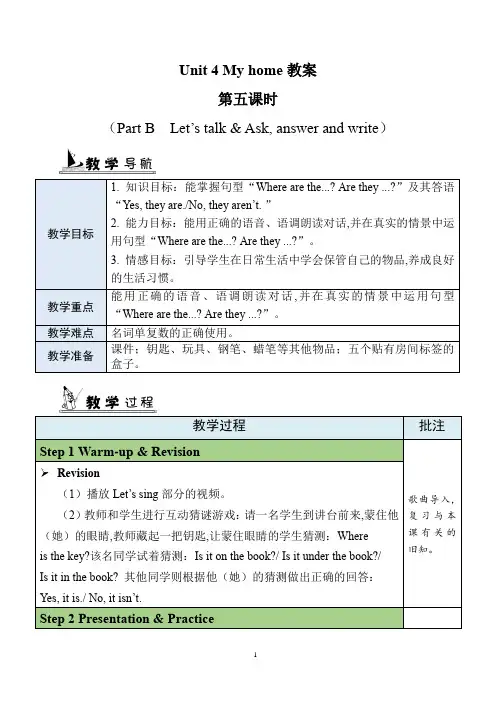
批注
Step 1 Warm-up& Revision
歌曲导入,复习与本课有关的旧知。
Revision
(1)播放Let’s sing部分的视频。
(2)教师和学生进行互动猜谜游戏:请一名学生到讲台前来,蒙住他(她)的眼睛,教师藏起一把钥匙,让蒙住眼睛的学生猜测:Where
is the key?该名同学试着猜测:Is it on the book?/ Is it under the book?/
播放该部分的录音,回答问题:Where are the keys?
出示答案及图片:They are in the door.
(3)Watch and repeat.
播放该部分的动画,学生听音模仿,使用正确的语音、语调朗读对话。教师注意及时纠正学生错误的发音。
(4)Role-play.
小组分角色表演对话。
nguage points.
(1)询问及回答某人或某物位置的句型:
问:Where are +人/物(第三人称复数)?
答:人/物(第三人称复数)+ are in/on/ under/near …
(2)猜测某人或某物位置的句型及其答语:
问:Are+人/物(第三人称复数)in/on/ under/near …?
同桌两人分别在自己的教材上填好代表物品的首字母,然后运用句型“Where are ...?Are they in/on/under/near...?”一起完成寻找物品的活动,回答的学生根据问题作答,可以利用这个活动巩固对话部分所学语言。
2.Game:Hide and Seek
(1)教师事先准备好的糖果、文具、钥匙等依次亮相,并用句型“They’re…”来描述这些物品。
人教PEP版四年级英语上册 Unit 4 Part B 第二课时 教学课件完整版

rdifeg oafs blate hopen
ciktnhe
fridge sofa table phone kitchen
Ask and answer in pairs.
A: Where is the phone? B: It’s near the TV. A: Where are the flowers? B: They are … A: Where is/are the …? B: It’s/They’re …
七彩课堂 Draw a picture of your
home.
Make a short dialogue use the words and
sentences we have
伴你成长 Introduce your picture
to your friends.
leardge. The fridge is near the window. D: Look at the kitchen. It has a fridge. The fridge is near the window. The fridge is green.
Practice in groups.
01
明确目标与主题
1-确定PPT目的 2-紧扣主题内容 3-适应受众需求
02
结构与布局规划
1-清晰逻辑框架 2-突出重点信息 3-统一风格与配色方案
03
文字与图片运用
1-简洁明了文字表达 2-高质量图片素材选择 3-图文结合增强视觉效果
04
幻灯片设计技巧
• 1-简洁美观幻灯片样式 2-恰当使用图表和数据展示 • 3-注重版式和排版规范 4-保持一致性和连贯性
人 教 PEP 版 英 语 四 年 级 上 册
(PEP)四年级英语上册教案 Unit 4 Part B Let’s talk
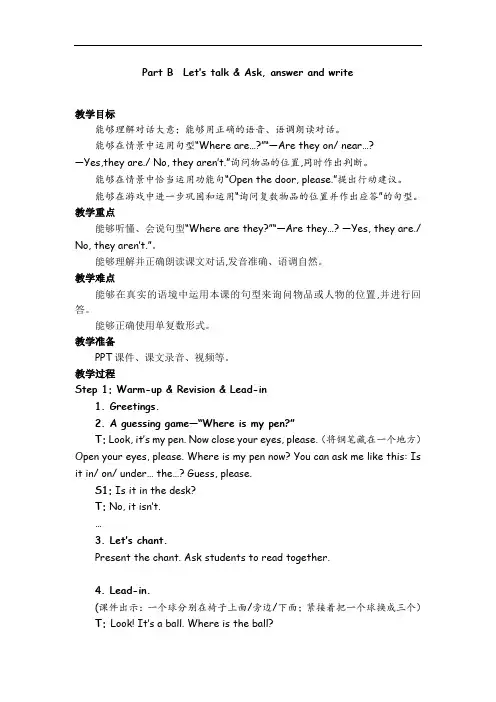
Part B Let’s talk & Ask, answer and write教学目标能够理解对话大意;能够用正确的语音、语调朗读对话。
能够在情景中运用句型“Where are…?”“—Are they on/ near…?—Yes,they are./ No, they aren’t.”询问物品的位置,同时作出判断。
能够在情景中恰当运用功能句“Open the door, please.”提出行动建议。
能够在游戏中进一步巩固和运用“询问复数物品的位置并作出应答”的句型。
教学重点能够听懂、会说句型“Where are they?”“—Are they…? —Yes, they are./ No, they aren’t.”。
能够理解并正确朗读课文对话,发音准确、语调自然。
教学难点能够在真实的语境中运用本课的句型来询问物品或人物的位置,并进行回答。
能够正确使用单复数形式。
教学准备PPT课件、课文录音、视频等。
教学过程Step 1: Warm-up & Revision & Lead-in1. Greetings.2. A guessing game—“Where is my pen?”T: Look, it’s my pen. Now close your eyes, please.(将钢笔藏在一个地方)Open your eyes, please. Where is my pen now? You can ask me like this: Is it in/ on/ under… the…? Guess, please.S1: Is it in the desk?T:No, it isn’t.…3. Let’s chant.Present the chant. Ask students to read together.4. Lead-in.(课件出示:一个球分别在椅子上面/旁边/下面;紧接着把一个球换成三个)T: Look! It’s a ball. Where is the ball?Ss: It’s on/ near/ under the chair.T: What are these?Ss: They are balls.T: Where are the balls? Guess!Ss: Are they…?…Step 2: Presentation1. Teach the new words and sentences.(课件出示:教材Unit 4主情景图中Amy家的图片)T: Amy can’t find her cat. Let’s help her! Is she in the kitchen? Guess!Ss: Yes, she is. / No, she isn’t.T: Open the door. Let’s have a look! Follow me: Open the doo r. (Help students understand the sentence with the action.)Ss:…T: The cat is near the table. Table, table, ta/teɪ/-ble/bl/, table. Read after me.Write down the word “table” on the blackboard and teach it.T: (课件出示:table与desk的对比图) We eat beside the table, the desk is for studying and working.(课件出示:教材Unit 4主情景图中Amy家的图片)T: Look at the table. What’s on the table?Ss:…T: (With a gesture.) Yes, it’s a phone. Phone, phone, ph/f/ -one/əʊn/, …Ss: …T:Now, Amy can’t find her crayons. Let’s help her! Are t hey in the kitchen?Ss: No, they aren’t. They are in the study.T: Are they on the desk?Ss: No, they aren’t. They are near the desk.Write down the sentence structures “—Are they…? —No, they aren’t.” on the blackboard and teach them.2. Let’s talk.(1) Look and predict.Show the pictures of “Let’s talk” and lead students to predict. (课件出示:教材P41 Let’s talk板块的图片)T: Who are they?Ss: John and his mother.T: What’s in John’s hand in Picture 1?Ss: Keys.T: Follow me: k/k/-ey/iː/, key/k iː/, keys/k iːz/.Writ e down the word “key” on the blackboard.T: What are they talking about?Ss:They are talking about the keys. They can’t find the keys.(2) Watch the video and answer the questions.Play the video and show the questions. (课件出示:教材P41 Let’s talk 板块的视频)Ask students to underline the answers in the book.(3) Watch the video again and check the answers.T: Are the keys on the table?Ss:No, they aren’t.T: Are they near the phone?Ss: No, they aren’t.T: Where are the keys?Ss:They’re in the door.Write dow n the sentences “—Where are the keys? —They’re in the door.” on the blackboard and teach them.Step 3: Practice1. Read and act.(1) Ask students to read after the recording and pay attention to the pronunciation and intonation.(2) Let students practice the dialogue in groups.(3) Act out the dialogue.2. Ask, answer and write.(1) Show the picture of “Ask, answer and write”.(出示课件)T: Look! Sarah writes a letter “p” in the circle on the desk. It means “The pens are on the desk.” Please read what Sarah and Wu Yifan say.Read the dialogue of Sarah and Wu Yifan.(2) Ask students to play the game in pairs according to the dialogue.T:Look at the picture. You can write k (keys), b (book), p (pens), g (glasses) in the circles. Then your partner guesses where you write them. Guess them like Sarah and Wu Yifan.(3)Show the dialogues.Step 4: Consolidation & Extension1. A guessing game—“What is it? / What are they?”T: (课件出示:书房场景图) Look at this picture. This is a study. What can you see in the study?Ss: …T: Now, I will say a thing. Please guess what it is or what they are. Listen carefully. They are near the phone. What are they?S1: They are keys.T: No, they aren’t.S2: They are books.T: Yes, they are books.T: Please ask and answer in pairs as above. Which pair wants to show your dialogue?2. Play a game—“The cat catches mice.”Divide students into four groups: red cat, white cat, black cat and yellow cat.T: A cat that catches a mouse is a good cat. There are three mice in Amy’s home. Where are they? The group that can catch the most mice is the winner.—Where are the mice?—Are they in the…(bedroom/ living room/ study/ kitchen/ bathroom/…)?—Yes, they are. / No, they aren’t.—Are they under/ behind/ near…the…(bed/ phone/ table/ door/…)?—Yes, they a re./ No, they aren’t.板书作业1. Listen and imitate the dialogue for three times.2. Do the exercises.教学反思1.教学过程中采用了以旧知带新知的学习方法,在复习单数形式的问句和答语的基础上,再进一步学习复数形式的句型,从而使学生在掌握新知时有一个阶梯性的接受过程。
人教pep版2019年秋四年级英语上册:unit_4_part_b_说课稿【精品】
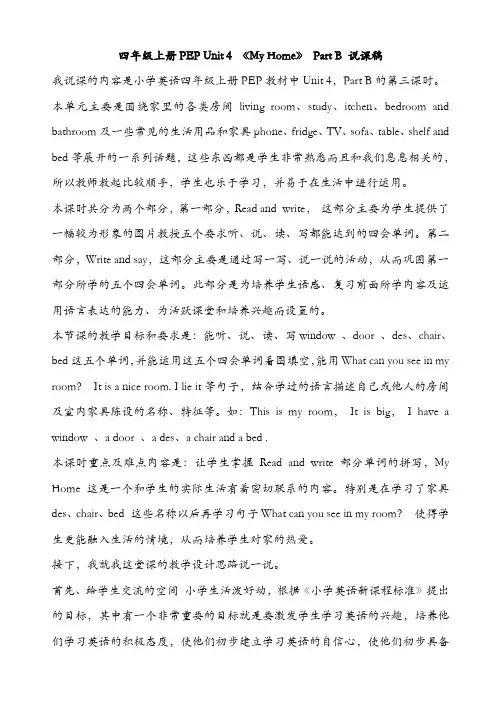
四年级上册PEP Unit 4 《My Home》Part B 说课稿我说课的内容是小学英语四年级上册PEP教材中Unit 4,Part B的第三课时。
本单元主要是围绕家里的各类房间living room、study、itchen、bedroom and bathroom及一些常见的生活用品和家具phone、fridge、TV、sofa、table、shelf and bed等展开的一系列话题,这些东西都是学生非常熟悉而且和我们息息相关的,所以教师教起比较顺手,学生也乐于学习,并易于在生活中进行运用。
本课时共分为两个部分,第一部分,Read and write,这部分主要为学生提供了一幅较为形象的图片教授五个要求听、说、读、写都能达到的四会单词。
第二部分,Write and say,这部分主要是通过写一写、说一说的活动,从而巩固第一部分所学的五个四会单词。
此部分是为培养学生语感、复习前面所学内容及运用语言表达的能力、为活跃课堂和培养兴趣而设置的。
本节课的教学目标和要求是:能听、说、读、写window 、door 、des、chair、bed这五个单词,并能运用这五个四会单词看图填空,能用What can you see in my room?It is a nice room. I lie it等句子,结合学过的语言描述自己或他人的房间及室内家具陈设的名称、特征等。
如:This is my room,It is big,I have a window 、a door 、a des、a chair and a bed .本课时重点及难点内容是:让学生掌握Read and write 部分单词的拼写,My Home这是一个和学生的实际生活有着密切联系的内容。
特别是在学习了家具des、chair、bed 这些名称以后再学习句子What can you see in my room?使得学生更能融入生活的情境,从而培养学生对家的热爱。
【精品】人教pep版2019年秋四年级英语上册:unit_4_part_b_说课稿
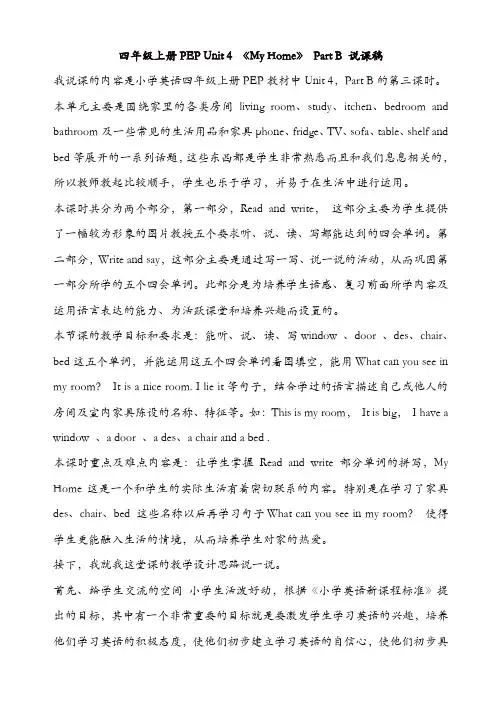
四年级上册PEP Unit 4 《My Home》Part B 说课稿我说课的内容是小学英语四年级上册PEP教材中Unit 4,Part B的第三课时。
本单元主要是围绕家里的各类房间living room、study、itchen、bedroom and bathroom及一些常见的生活用品和家具phone、fridge、TV、sofa、table、shelf and bed等展开的一系列话题,这些东西都是学生非常熟悉而且和我们息息相关的,所以教师教起比较顺手,学生也乐于学习,并易于在生活中进行运用。
本课时共分为两个部分,第一部分,Read and write,这部分主要为学生提供了一幅较为形象的图片教授五个要求听、说、读、写都能达到的四会单词。
第二部分,Write and say,这部分主要是通过写一写、说一说的活动,从而巩固第一部分所学的五个四会单词。
此部分是为培养学生语感、复习前面所学内容及运用语言表达的能力、为活跃课堂和培养兴趣而设置的。
本节课的教学目标和要求是:能听、说、读、写window 、door 、des、chair、bed这五个单词,并能运用这五个四会单词看图填空,能用What can you see in my room?It is a nice room. I lie it等句子,结合学过的语言描述自己或他人的房间及室内家具陈设的名称、特征等。
如:This is my room,It is big,I have a window 、a door 、a des、a chair and a bed .本课时重点及难点内容是:让学生掌握Read and write 部分单词的拼写,My Home这是一个和学生的实际生活有着密切联系的内容。
特别是在学习了家具des、chair、bed 这些名称以后再学习句子What can you see in my room?使得学生更能融入生活的情境,从而培养学生对家的热爱。
人教版pep四年级英语上册PEP Unit 4 《My Home》 Part B 县级优质课说课稿
四年级上册Unit 4《My home》一、说教材,《My home》是PEP教材四年级上册第四单元,这一单元的教学内容都是围绕“家”这一学生喜闻乐见的主题展开的。
这节课为新授课,是第四单元第一课时,也是A部分的第一课时,有Let’s learn 和Let’s do。
这节课的教学内容是要学习有关房间的五个单词及进行简单的对家的介绍。
句型Go to…和五个房间有关的动作短语,这些短词汇都是学生在日常生活中经常见到的事物,与小学生的生活和学习密切相关。
本课时是本单元的重点,本节课掌握程度的好坏,直接会影响到本单元后阶段有关“描述和询问东西在哪里”的对话和故事的掌握,在本单元教学中具有举足轻重的地位。
依据本单元的话题,本节课的内容和学生现有的认知水平确定以下教学目标:(一)能够听说,认读五个新单词“study living room. Kitchen,bathroom,bedroom.”(二) 能听懂“let’s do”的指令,并做出相应的动作,能用“This is my home,This is a living room...”句型简单介绍房子。
(三)培养学生口语表达,交际能力,培养学生对家的热爱,鼓励学生大胆设想自己未来的家居。
这样确定教学目标,使“三维”目标紧密结合,在同一教学过程中,互相渗透,共同完成,而且目标具体,可检测。
由于本课是第四单元的新授课,将训练学生听、说、认读新单词的能力以及听懂“Let’s do”部分中指令并做相应的动作为教学重点。
《My home》part A Let’s do 通过单词及指令的学习和掌握,能综合灵活运用所学语言,并描述卧室中的物件,并能据此编出对话做为本课的教学难点。
二、说教法在本节课的设计中,充分利用直观,实用的教具,吸引学生注意力激发许文胜兴趣,制作了课件,利用多媒体优势,创设佳境,在教法总体构思上注重学生听、说、唱、玩、演几方面能力的综合训练,采用直观教学法,TPR活动教学法,用游戏激发学生学习英语的兴趣,训练和形成学生的英语能力三、说学法因为教为学服务,所以在教学过程中,让学生仔细听音,观察老师发音口型,认真模仿,让学生分组练习,用玩游戏的方式进行知识的巩固,通过学生动脑、动口、动手等方式,培养学生学习兴趣以及运用英语交际沟通的能力。
人教PEP版英语四年级上册课件Unit4B Let's learn -附教案说课稿
What can you see in the room?
Presentation
Let's learn
Lead in Let 's visit John's home. This is John's home.
There is a bear in the John's room.
The bear is on the__b_e_d__ .
同步教案
提示:双击打开后可根据需要进行编辑,打印,保存。
欢
迎
下
载
说课稿
提示:双击打开后可根据需要进行编辑,打印,保存。
欢
迎
下
载
导学案
提示:双击打开后可根据需要进行编辑,打印,保存。
欢
பைடு நூலகம்
迎
下
载
教学反思
提示:双击打开后可根据需要进行编辑,打印,保存。
欢
迎
下
载
THANK YOU!
点 击 图 片 , 播 放 视 频
Practice
Look and say
Where is…? Where are…?
Look and say
An English book, a pencil box. An eraser and a pen.
What's in your schoolbag?
Let's play
短语: on the table 在桌子上 The table is clean.
Where are the books?
They are on the
_s_o_f_a__.
短语: on the sofa 在沙发上 He is on the sofa.
【精品】人教pep版2019年秋四年级英语上册:unit_4_part_b_说课稿
四年级上册PEP Unit 4 《My Home》Part B 说课稿我说课的内容是小学英语四年级上册PEP教材中Unit 4,Part B的第三课时。
本单元主要是围绕家里的各类房间living room、study、itchen、bedroom and bathroom及一些常见的生活用品和家具phone、fridge、TV、sofa、table、shelf and bed等展开的一系列话题,这些东西都是学生非常熟悉而且和我们息息相关的,所以教师教起比较顺手,学生也乐于学习,并易于在生活中进行运用。
本课时共分为两个部分,第一部分,Read and write,这部分主要为学生提供了一幅较为形象的图片教授五个要求听、说、读、写都能达到的四会单词。
第二部分,Write and say,这部分主要是通过写一写、说一说的活动,从而巩固第一部分所学的五个四会单词。
此部分是为培养学生语感、复习前面所学内容及运用语言表达的能力、为活跃课堂和培养兴趣而设置的。
本节课的教学目标和要求是:能听、说、读、写window 、door 、des、chair、bed这五个单词,并能运用这五个四会单词看图填空,能用What can you see in my room?It is a nice room. I lie it等句子,结合学过的语言描述自己或他人的房间及室内家具陈设的名称、特征等。
如:This is my room,It is big,I have a window 、a door 、a des、a chair and a bed .本课时重点及难点内容是:让学生掌握Read and write 部分单词的拼写,My Home这是一个和学生的实际生活有着密切联系的内容。
特别是在学习了家具des、chair、bed 这些名称以后再学习句子What can you see in my room?使得学生更能融入生活的情境,从而培养学生对家的热爱。
PEP小学英语第四册Unit4PartB第一课时说课稿doc
通过对知识的小结,帮忙学生将本课的信息加工、贮存,从而明确教学目标、重点和难点,对学生的表现进行总结评判,以评判增进展,培育小组团队精神,鼓励学生斗胆开口,踊跃活动,为小组争得荣誉。
安义万埠小学 余陆
(2)能力目标:能看懂、听懂天气预报并用英文表达天气情形。
(3)情感目标:培育学生学习的愿望及合作交流能力。
3、教学重难点
五个形容词及交际性语言的学习是本课的重点及难点,培育学生合作的能力,同时注意培育学生学习英语的爱好,树立自信心也是一个教学难点。
4、教法、学法
为了冲破这堂课的重、难点,依照小学生好奇、好胜、好动、仿照力强等生理和心理特点,我采取了歌曲导入法、游戏感悟法、情境创设法、多媒体辅助法等的教学方式,坚持以话题为核心、以任务型教学模式为主、以合作、活动为主线,安排本课教学。由天气预报开始,创设外语语言气氛,激发学生学习的爱好,使学生在参与天气情形的表述活动中享受到学习的欢乐,取得相关的知识,培育学生对英语运用的实践能力,让他们成为学习的主人。
二、教学目标
《新英语课程标准》指出:激发和培育学生学习英语的爱好,使学生树立信心,养成良好的学习适应和形成有效的学习策略,进展学生自主学习的能力和合作精神是小学英语教学的大体任务。在认真分析教材的基础上,将本课时的教学目标及重点、难点确信如下:
(1)知识目标:能听、说、认读本课时的中的单词:rainy、snowy、windy、sunny、cloudy.
(二)呈现新知
在小学英语课堂中使学生维持一种踊跃的紧张感,能够激发他们学习的外部动机,引发他们一系列的自主活动,增进外部动机向内部动机的转化。Today,we’re going to learn “Unit4 It’s warm today”. I’ll divide you into four groups. Which one is best, they’ll get the flag. OK? Now, let’s start.于是我提出问题 It’s cool in Beijiin. What about London? 引入主题,并通过Look at the map of the world. Here’s London.自然引入新词的学习。在学习新单词的进程中,以形象、直观的图片引出单词,并简单介绍相关城市的天气特色,使学生不仅能学到新单词,而且能够了解到一些相关知识。教读单词时,配上相应的动作和表情,如:及不同的带读方式,让学生动起来,融入动脑、动口、动手的英语学习中。
- 1、下载文档前请自行甄别文档内容的完整性,平台不提供额外的编辑、内容补充、找答案等附加服务。
- 2、"仅部分预览"的文档,不可在线预览部分如存在完整性等问题,可反馈申请退款(可完整预览的文档不适用该条件!)。
- 3、如文档侵犯您的权益,请联系客服反馈,我们会尽快为您处理(人工客服工作时间:9:00-18:30)。
四年级上册PEP Unit 4 《My Home》Part B 说课稿
我说课的内容是小学英语四年级上册PEP教材中Unit 4,Part B的第三课时。
本单元主要是围绕家里的各类房间living room、study、kitchen、bedroom and bathroom及一些常见的生活用品和家具phone、fridge、TV、sofa、table、shelf and bed等展开的一系列话题,这些东西都是学生非常熟悉而且和我们息息相关的,所以教师教起来比较顺手,学生也乐于学习,并易于在生活中进行运用。
本课时共分为两个部分,第一部分,Read and write,这部分主要为学生提供了一幅较为形象的图片来教授五个要求听、说、读、写都能达到的四会单词。
第二部分,Write and say,这部分主要是通过写一写、说一说的活动,从而巩固第一部分所学的五个四会单词。
此部分是为培养学生语感、复习前面所学内容及运用语言表达的能力、为活跃课堂和培养兴趣而设置的。
本节课的教学目标和要求是:能听、说、读、写window 、door 、desk、chair、bed这五个单词,并能运用这五个四会单词看图填空,能用What can you see in my room?It is a nice room. I like it等句子,结合学过的语言来描述自己或他人的房间及室内家具陈设的名称、特征等。
如:This is my room,It is big,I have a window 、a door 、a desk、a chair and a bed .
本课时重点及难点内容是:让学生掌握Read and write 部分单词的拼写,My Home这是一个和学生的实际生活有着密切联系的内容。
特别是在学习了家具desk、chair、bed 这些名称以后再学习句子What can you see in my room?使得学生更能融入生活的情境,从而培养学生对家的热爱。
接下来,我就我这堂课的教学设计思路说一说。
首先、给学生交流的空间小学生活泼好动,根据《小学英语新课程标准》提出的目标,其中有一个非常重要的目标就是要激发学生学习英语的兴趣,培养他们学习英语的积极态度,使他们初步建立学习英语的自信心,使他们初步具备用英语进行简单日常交流的能力。
因此小学英语课堂进行的活动教学应该是能直接激发小学生对语言学习的兴趣,能使小学生的多元智能在交际活动中得以体现和发展。
因而,我在设计这堂课时,一直注意尽可能的把课堂还给学生,让学生与学生,学生与老师之间多进行语言的交流。
如:在热身运动中,进行日常的见面对话。
在句型的学习中,我让学生根据自己房间中的实际情况,进行同桌间的相互介绍等等。
我都努力着尽可能地为学生创造比较多的交流机会。
其次、采用游戏,提高学生兴趣小学生学英语最重要的是要培养他们学习英语这种语言的兴趣。
孔子说过:“知之者不如好之者,好之者不如乐之者。
”爱因斯坦说过:“热爱是最好的老师”。
只有激发了学生的兴趣,调动了学生的热情,那么这样的知识就是学生善于接受,记忆深刻的。
因此,我采用游戏的方式导入新课,如:I have a big room ,In my room ,I have a door、a desk、a chair、a bed,I like it very much,Do you like my room ?welcome to my room!然后
出示Read and write的图片,让学生四人合作小组学习,在认一认、听一听、读一读、拼一拼中四人小组talk about the picture. 我在这堂课上安排了两个比较简短的游戏。
如游戏Quick :任意拿出一张已经准备好的单词卡片问What Is this ? Can you spell the word “desk”?让学生快速反应,以培养学生的观察力、快速反应能力和竞争意识。
并使他们在这种强烈的竞争意识中,提高注意力与他们的兴趣。
再如游戏Write and match:将四会单词字母顺序打乱,比一比谁在最短的时间内排好单词,让学生拼写单词和连线,在写一写和连一连中提高课堂兴趣,并且在写一写中达到了复习所学单词的目的。
同时也在这个过程中培养了学生的思维能力。
再次、联系实际,贴近生活My Home本身就是一个与生活有着紧密联系的话题。
我从这一点出发,紧紧围绕生活来开展教学。
在Write and say这部分内容的教授中,我通过介绍我自己房间里的家具,如:This is my room,you can see a window、a door、a desk、a chair、a bed,Oh,It is a nice room . I like it,引出句型What can you see in my room ?引导学生说:I can see a window、a door、a desk、a chair、a bed,Oh,It is a nice room . I like it,然后安排同桌间拿出自己准备的房间图片,根据房间图片,相互之间询问。
要求学生简单描述自己的房间,结合学过的语言描述房间内家具陈设的名称、特征等。
学生看着自己亲手绘制的房间图片,亲切感、生活的真实感都一股脑儿地涌上心头。
此时他们用学习的语言进行交流的愿望也就特别强烈。
最后、渗透情感教育让学生通过谈论自己的房间,
培养学生对家的热爱之情;我在这样的教学中渗透了学生热爱家庭的情感教育:因为,家是我们每个人永远的港湾,我们要爱家,爱护家里的每一样家具。
总而言之,我在设计这堂课时,尽可能地采用听、说、游戏的方式,通过各个有趣、实用、轻松、活泼的活动,使每个学生都参与进来,充分调动学生的积极性和主动性。
当然,由于自己水平有限,各个环节之间还不够连贯,还存在着很多很多的缺点和不足,愿各位评委、各位专家提出宝贵的意见和建议。
1、Thank you very much for taking me with you on that splendid outing to London. It was the first time that I had seen
the Tower or any of the other famous sights. If I'd gone alone, I couldn't have seen nearly as much, because I wouldn't
have known my way about.The weather was splendid on that day, which I thought was rare. I still remember some people
told me that in Britain there was weather and no climate. During the same day, it might snow in the morning, rain
at noon, shine in the afternoon and be windy before the night falls. So I think I was lucky。
20.8.138.13.202017:4917:49:08Aug-2017:49
2、最困难的事情就是认识自己。
二〇二〇年八月十三日2020年8月13日星期四
3、有勇气承担命运这才是英雄好汉。
17:498.13.202017:498.13.202017:4917:49:088.13.202017:498.13.2020
4、与肝胆人共事,无字句处读书。
8.13.20208.13.202017:4917:4917:49:0817:49:08
5、阅读使人充实,会谈使人敏捷,写作使人精确。
Thursday, August 13, 2020August 20Thursday, August 13,
20208/13/2020
6、最大的骄傲于最大的自卑都表示心灵的最软弱无力。
5时49分5时49分13-Aug-208.13.2020
7、志气这东西是能传染的,你能感染着笼罩在你的环境中的精神。
那些在你周围不断向上奋发的人的胜利,会鼓励激发你作更艰苦
的奋斗,以求达到如象他们所做的样子。
20.8.1320.8.1320.8.13。
2020年8月13日星期四二〇二〇年八月十三日
8、时间是一位可爱的恋人,对你是多么的爱慕倾心,每分每秒都在叮嘱:劳动,创造!别虚度了一生!。
